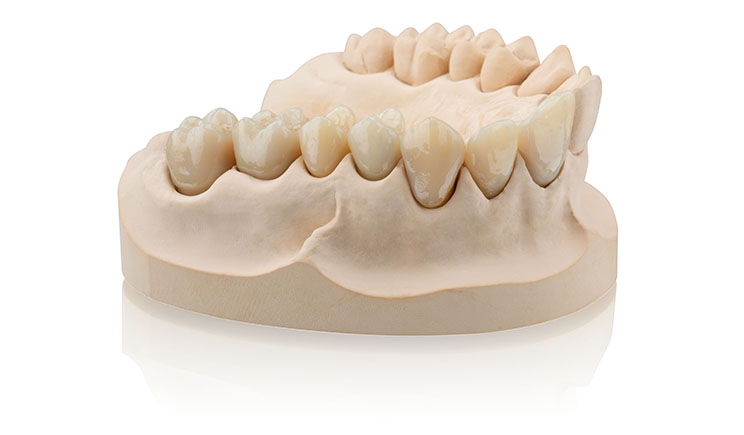
When Dr. Édouard Lanoiselée met a patient who needed an old amalgam inlay restoration changed with a tooth color restoration, the typical process was straightforward. But he took this as an opportunity to seek a new solution.
Already using intraoral scanning and digital software for other procedures, he chose to take a new approach to the workflow and rehabilitate the patient with innovative 3D printing solutions. It wasn’t just to use technology for technology’s sake, though, as 3D printing allowed the restorations to be directly printed.
The approach Dr. Lanoiselée took to create these restorations is indicative of the future of restorative dentistry. For years, milling machines have been the gold standard for CAD/CAM in dentistry, especially for the restorative field because of their impressive accuracy. However, their hefty price tag makes them cost prohibitive for many dental labs and offices.
Enter 3D printed restorative dentistry. Available at a fraction of the cost without sacrificing quality, accuracy, or material versatility, 3D printing as a tool for restorative dentistry is coming into its own in 2021 and will truly reshape how we approach dental restorations.
Restorative dentistry has already undergone a digital transformation, having adopted intraoral scanning, CBCT, and milling of zirconia or lithium disilicate as the gold standard. However, 3D printing, or additive manufacturing, hasn’t been used widely yet for fabrication of crowns or other types of restorations because of a lack of materials capable of providing the desired mechanical properties, accuracy, and fit to tooth preparations or other structures. Moreover, real case studies and research are fundamental to support new materials and workflows.
But we saw several major 3D printing companies, including Formlabs, announce in 2020 that they are developing solutions that meet these criteria.
Dental 3D Printing: 30 Years in the Making
Did you know that the first stereolithography (SLA) 3D printers were developed more than 30 years ago? These models, each with a build volume of a modern-day desktop 3D printer but the footprint of an industrial refrigerator, pioneered novel advances in dental treatment, most notably clear aligner therapy. But the companies that held the patents on those early machines kept their industry secrets close, limiting the market to large, expensive 3D printer models that only the largest dental laboratories could afford.
In the past 10 years, the industry has been changed by Formlabs and other 3D printer manufacturers, and this new proliferation of 3D printers has lowered the cost and the footprint while keeping quality high. The dental industry’s best and brightest have quickly begun innovating with this newly available powerful technology.
2021 is the year of 3D printing, now that the quality, accuracy, and breadth of materials available has enabled a new milestone in innovation: direct-printed restorations.
Material Innovation is Driving Dental Innovation
Today, there are already 3D printers that can meet the high demand and strict requirements needed for permanent crowns, inlays, onlays, and veneers. In the past five years, there has also been an increase in adoption and accessibility for 3D printing in dental that has opened the door to validating these cutting-edge materials for different indications.
For example, Formlabs designed its Permanent Crown Resin to move restorative dentistry forward. This tooth-colored, ceramic-filled resin enables 3D printing for permanent single crowns, inlays, onlays, and veneers. With an accessible price point and low per-part cost, it enables dental businesses of all sizes to achieve high-quality restorations through 3D printing.
Advances in material science are providing the dental industry with a new level of utility and versatility. In 2021, we will see the rise of material science as a key success driver for the 3D printing industry and the dental industry. New materials unlock new applications, from clear aligners to dentures to crowns and bridges.
A key to this advancement is the work being done in developing biocompatible resins, or plastics that can interact safely with the human body. Resins that are produced in ISO 13485 certified and FDA-registered facilities and tested for biocompatibility and sterilization compatibility enable a range of innovative applications, allowing solutions-oriented dental professionals to improve clinical outcomes, personalize treatments, and mitigate unnecessary costs.
Ask the Experts
So, how do these new solutions stack up? As the clinical protocols manager for Formlabs, I can share impressions of our new material designed to directly print permanent restorations from our beta testers.
“It’s a very strong resin,” said Dr. Rick Ferguson, who was able to print a full set of upper and lower anterior veneers in just one hour and was pleased with the quality. “Frankly, they fit as well as any lab-fabricated veneer we’ve ever used.”
“I really like this material for implant restorations because it’s softer than a ceramic or zirconia, which is beneficial for an implant. You don’t want to cause stress on the crestal bone or in the prosthetic components,” said Dr. Cory Glenn.
“This is a new step in the world of additive manufacturing. With reduced printing times, resins are more and more efficient, production costs are reduced, and the use of a simple workflow allows us to place the 3D printing at the heart of our daily activity,” said dental technician Samuel Morice, co-director of Argoat Prothèse in France. “Printing permanent prostheses is a real comfort! A new era is emerging to manage and produce clinical cases.”
With this reception from even early results and testing, 3D printing promises to increase its impact in the coming year.
Dr. Praderi is a trained dentist from Universidad Católica del Uruguay. She spent three years working at the university’s emergency service and in private dental practice before joining Formlabs Dental as clinical protocols manager. She conducted a research study in the area of aesthetic dentistry, which she presented to the International Association for Dental Research.
Related Articles
Diagnostic Intraoral Scanning: Technology Enhances Patient Education, Diagnosis, and Treatment











